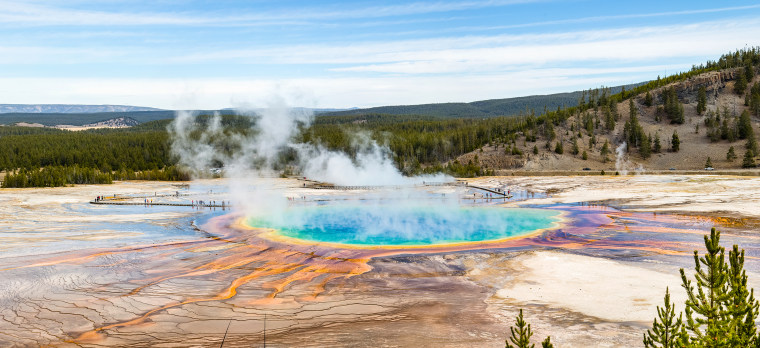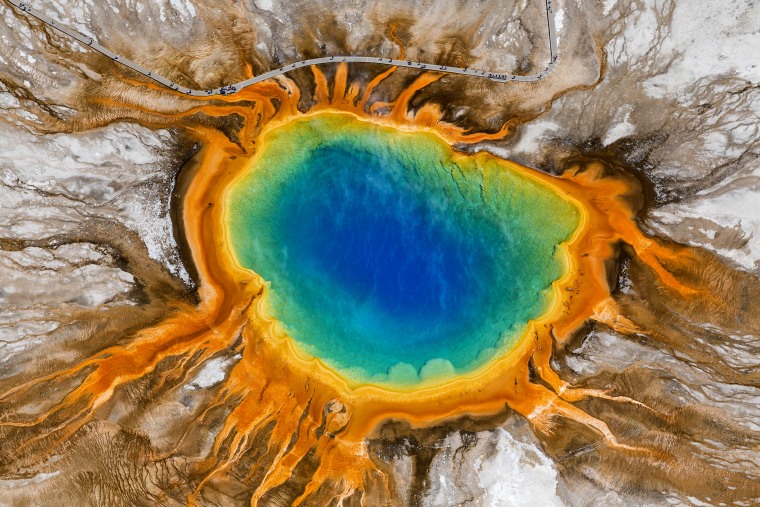Humans have witnessed many cataclysmic volcanic eruptions, from the one that destroyed Pompeii in 79 A.D. to the extraordinary Krakatoa eruption of 1883. But around the world right now there are about 20 so-called “supervolcanoes” that could outdo them all.
One of these monster volcanoes lurks beneath Yellowstone National Park. The Yellowstone Caldera is an enormous craterlike depression measuring 30 miles by 45 miles and filled with molten material (magma). If it were to blast its innards out in a super-eruption, it’s no exaggeration to say that the human race could be imperiled.
But scientists at NASA have sketched the rough outlines of a plan that they say would not only spare us from a deadly super-eruption but also turn the Yellowstone supervolcano into a source of electric power. In a write-up of the plan first shared with the BBC, the team argues that we could siphon heat from the caldera until it becomes too cool to erupt — and convert the geothermal energy into electricity.

“The primary objective…is to gradually defang Yellowstone as a threat to humanity,” says Dr. Brian Wilcox, an aerospace engineer at NASA’s Jet Propulsion Laboratory in Pasadena, California.
That’s a noble goal, but could the team’s provocative ideas really work? “It’s pie in the sky right now,” says Dr. Charles Connor, a volcanologist at the University of South Florida in Tampa, “but it’s a great trajectory to think about.”
Chilling out
A supervolcano eruption can spew out hundreds of cubic miles of magma. Fortunately, such outbursts are rare. The last super-eruption happened about 74,000 years ago — long before civilization’s rise. Geologic evidence suggests that Yellowstone’s supervolcano mounts a massive eruption once every 600,000 to 800,000 years. The most recent occurred about 640,000 years ago.
Those facts may be reassuring, but experts say they’re no excuse for complacency.
“Even though it’s unlikely to happen in anybody’s given lifetime, it will eventually happen,” Wilcox says of a supervolcano eruption. “One of these things is going to blow, and it’s going to be devastating.”
In a Yellowstone super-eruption, everything within 60 miles could be incinerated. Wyoming and surrounding states could be blanketed with three feet of volcanic ash, and some ash would likely spread over most of North America. The dust and gases released by the eruption would blot out enough sunlight to wipe out crops and plunge the world into a “volcanic winter” that could last for a decade or more. The ensuing famine could kill untold millions.
But Wilcox and his colleagues say we could lower the risk by drilling into the hot rock near Yellowstone’s magma chamber, starting several miles outside the park.
Water would be pumped through the borehole into the hot rock and then return to the surface at a temperature of more than 600 degrees Fahrenheit. The hot water could be used to drive turbines to generate electric power. Then the water, now cooled, could be pumped back underground to steal away more heat.
Great care would need to be taken to make sure the drilling process didn’t inadvertently trigger an eruption. Going slowly and approaching the magma chamber from the sides and beneath would be the safest approach, according to Wilcox. And he says it would all be surprisingly feasible.
“Most people think of a supervolcano as this amazingly massive thing that is so huge compared to puny human engineering capabilities,” Wilcox says. “It’s not so much that the amount of heat represented is so vast beyond human experience. It’s that it’s stored for a very, very long period of time and then released all at once.”
As outlined by the NASA scientists, the project would cost about $3.46 billion. It would take thousands of years for all the heat to be fully extracted. Throughout that time, as the risk of an eruption slowly subsided, there would be plenty of heat to generate electricity at competitive prices.
Beyond human experience
Engineers aren’t about to descend on Yellowstone with drills. But Wilcox hopes his idea will spark discussion about the threat posed by a supervolcanic eruption — and how we might mitigate it. “Keeping these volcanoes from devastating the human food supply and causing the deaths of 99 percent of all of humanity, that seems like a worthwhile thing to debate,” he says.
Connor agrees that it’s time to consider how to keep monster volcanoes from blowing their tops. “These are geological events which are beyond our experience, and humanity’s not prepared to deal with them,” he says. “Honestly, in the case of a super-eruption what else would we do? We have to try geoengineering.”

